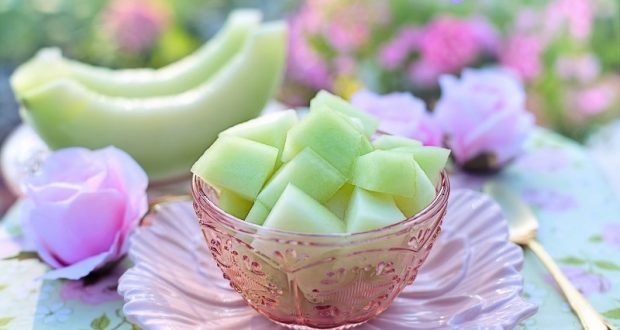 By Bob Labozetta (UC Master Gardener, Mariposa)
By Bob Labozetta (UC Master Gardener, Mariposa)
Sweet melons are cucurbits, along with cucumbers, pumpkins, and squash. They similarly enjoy a long, warm summer — something we have plenty of in the Sierra foothills. Here, they can be directly seeded in fertile, loamy soil that has reached at least 65℉ – 70℉. You can plant 6 seeds in small hills, thinning them to 3 plants per hill when the plants have two to three true leaves.
If you want to start plants earlier, remember that — like all cucurbits — they do not like their roots disturbed. Sow them in 2-inch or larger biodegradable pots to transplant whole when all danger of frost has passed and there are two to three true leaves. Again, two or three plants per hill with hills 3 to 6 feet apart.
Melons can also be trellised one foot apart. Row cover material can be suspended with PVC hoops early in the season to keep insect pests such as cucumber beetles and flea beetles off the plants. Remove the row covers when the plants start to bloom.
Water the plants regularly when young, but cut back on the water when melons are forming. At that point, water them deeply a couple of times a week.
When is a melon ripe for picking? Cantaloupes and other melons that have netted rinds will change the color under the netting (known as “ground color”) to a golden hue as the fruit ripens. When the melon is truly ripe, it smells sweet, is slightly soft at the end opposite where the fruit was attached to the vine, and will slip (separate) easily from the stem or vine.
Honeydews, on the other hand, do not exude a sweet, ripe smell nor do they separate from the stem/vine easily when ripe. Instead, look for the color of the rind to change from green to a creamy yellow. It is best to use hand pruners to cut the melon from the vine.
And then there are watermelons. They, too, do not slip from the stem/vine easily. When ready to harvest, the tendril between the stem/vine and the watermelon will dry up and shrivel. Also, the spot where the watermelon has been in contact with the ground will turn from green to a yellowish tint, especially if you do not turn the melon as it is growing. Again, it is best to snip the melon from the stem/vine with hand pruners or the like.
You don’t need an orchard to grow sweet summer fruit — just grow melons!
+++++++++++++++++++++++++++++++++++++++++++++++++++++++++++++++++++++++
UC Master Gardeners of Mariposa County serves Mariposa County, including Coulterville, Greeley Hill and Don Pedro. For gardening and event information, call us at 209-966-7078 or email mgmariposa@ucdavis.edu.
Find us online at http://cemariopsa.ucanr.edu/Master_Gardener, on Facebook (UC Master Gardeners of Mariposa County), and on YouTube at “UCCE Mariposa”. Listen to us on KRYZ 98.5 FM radio Wednesdays at 2 p.m. and Saturdays at 5 p.m.




